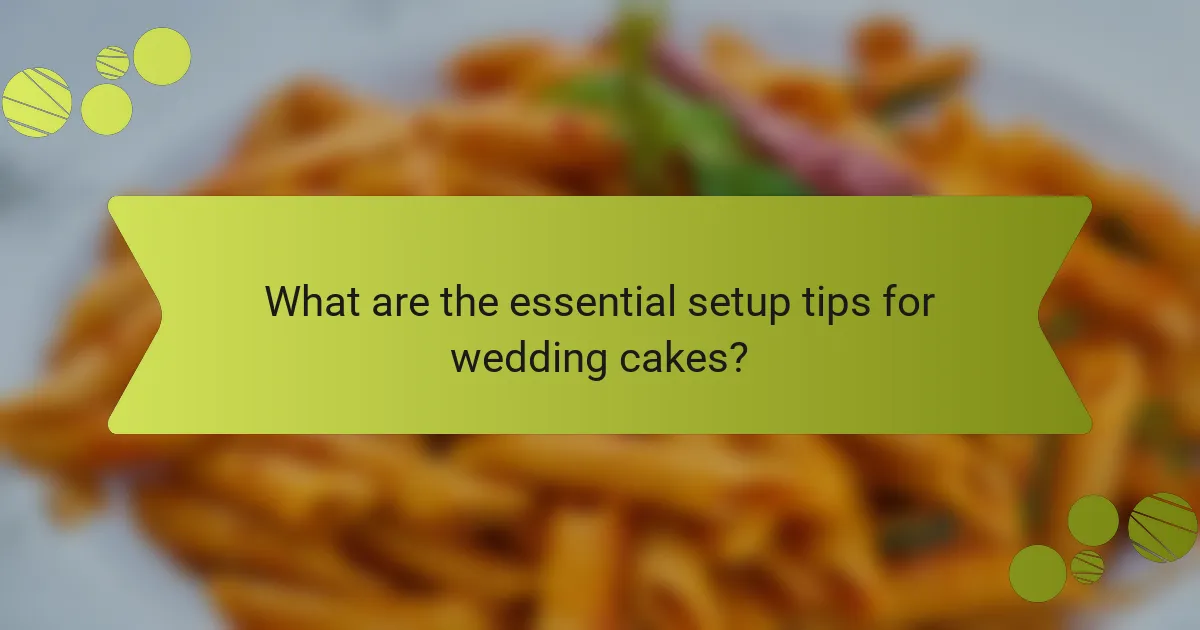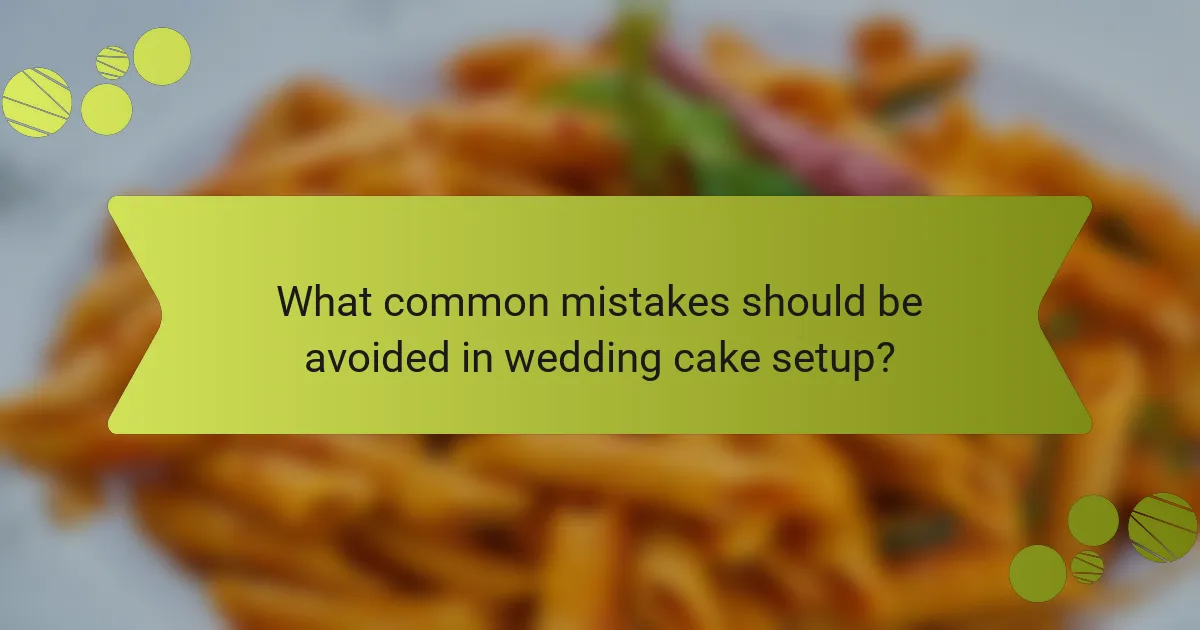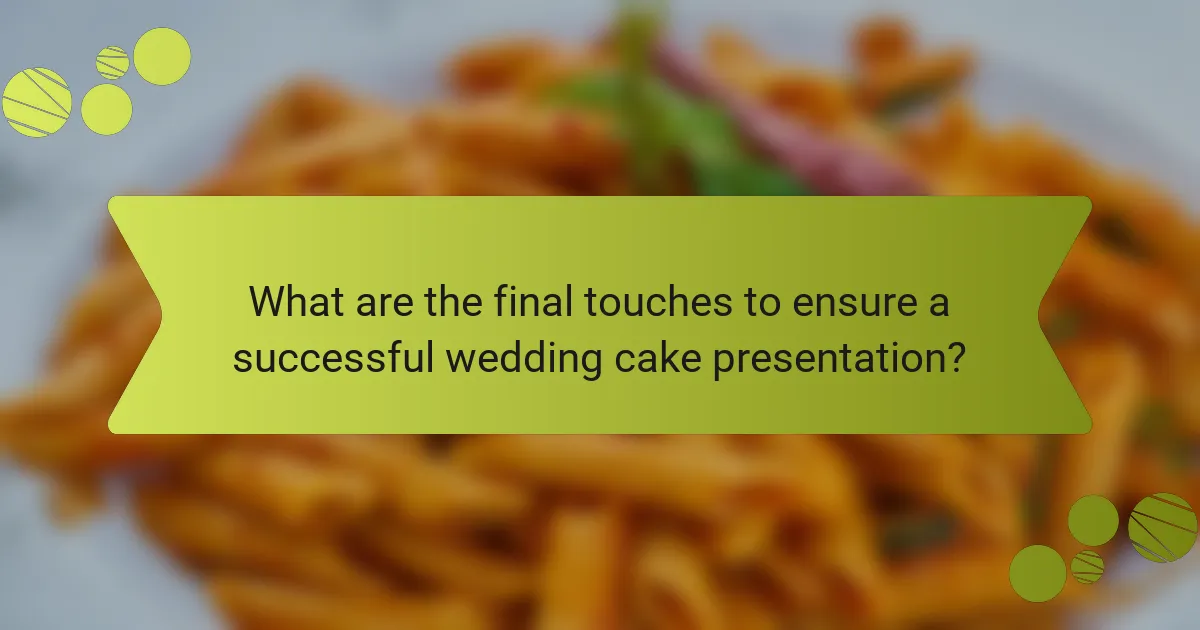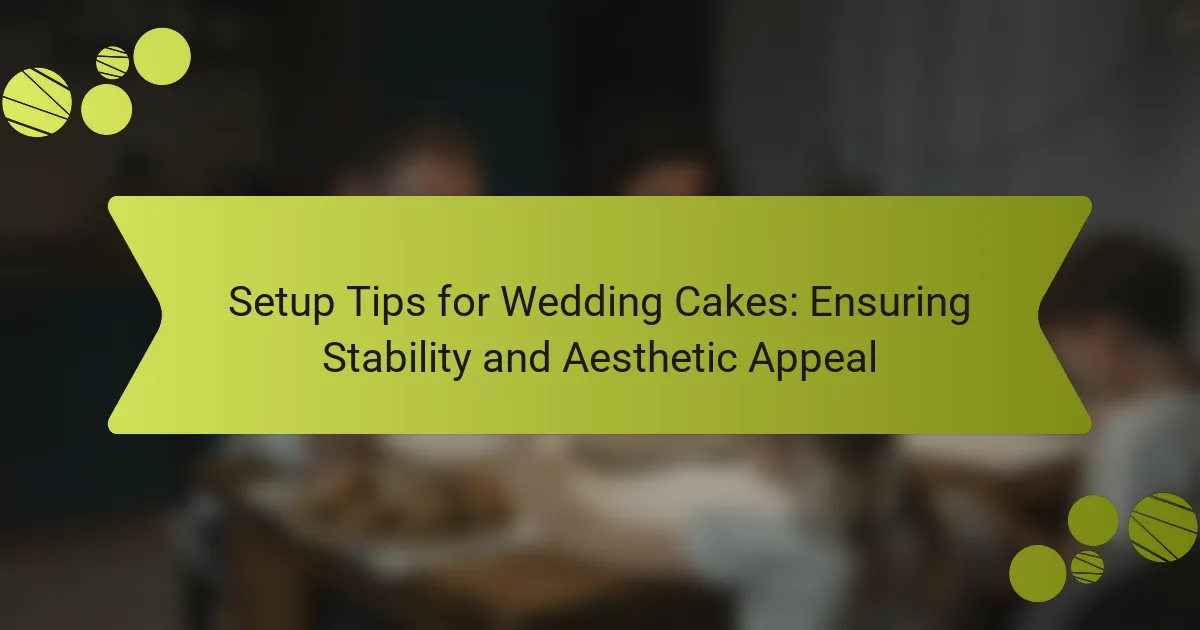The article provides essential setup tips for wedding cakes, focusing on ensuring both stability and aesthetic appeal. Key recommendations include placing the cake on a sturdy, level surface, using an appropriately sized cake board, and securing multi-tier cakes with dowels for weight distribution. It emphasizes the importance of temperature control to maintain texture and prevent melting, as well as the use of lightweight decorative elements to avoid structural pressure. Common mistakes such as inadequate support, improper leveling, and poor lighting are highlighted to help achieve a visually appealing and stable cake presentation.

What are the essential setup tips for wedding cakes?
Ensure the wedding cake is placed on a sturdy, level surface. This prevents tilting and ensures stability. Use a cake board that is at least one inch larger than the cake. This provides support and makes transportation easier. Secure the cake with dowels if it has multiple tiers. Dowels help distribute weight evenly and prevent collapsing. Keep the cake in a cool, dry place until serving time. This preserves the cake’s texture and prevents melting. Use decorative elements that are lightweight to avoid adding unnecessary pressure. Finally, have a clear plan for cutting and serving the cake to maintain its structure. These tips ensure the cake remains beautiful and stable throughout the event.
How do you ensure stability in a wedding cake setup?
To ensure stability in a wedding cake setup, use dowels or support systems. Dowels are inserted into each tier to distribute weight evenly. This prevents top-heavy tiers from collapsing. Additionally, a sturdy base is essential. A cake board should be used beneath each tier. The board must be the same diameter or slightly larger than the cake tier.
Chilled cakes are also more stable. Refrigerating the cake before setup helps firm the frosting. This reduces the risk of sliding during transport. Use a level surface for the cake display. An uneven surface can lead to tipping or sliding.
Finally, secure the cake with a non-slip mat or adhesive if necessary. This adds an extra layer of stability. Following these steps ensures that the cake remains intact throughout the event.
What base supports are necessary for a stable wedding cake?
A stable wedding cake requires a sturdy base support system. The most common supports are cake boards, which provide a foundation for each cake tier. These boards should be at least a quarter-inch thick for adequate strength. Additionally, dowels or straws are essential for internal support, helping to distribute weight evenly. Each tier should have its own dowels, placed in a circular pattern. Using a central dowel can further secure the tiers together. For larger cakes, a cake drum may be used as a base, offering extra stability. Properly constructed supports prevent collapsing and ensure the cake maintains its shape during transport and display.
How does the cake’s weight distribution affect stability?
The cake’s weight distribution directly impacts its stability. Even weight distribution across the cake ensures that it remains balanced. If the weight is uneven, the cake may lean or topple. Heavier layers should be placed at the bottom to lower the center of gravity. This placement prevents top-heavy situations that compromise stability. Proper support, like dowels, can help manage weight distribution. A well-balanced cake is less likely to shift during transport or display. Overall, careful consideration of weight distribution is crucial for maintaining a stable structure.
What aesthetic factors should be considered when setting up a wedding cake?
The aesthetic factors to consider when setting up a wedding cake include color, design, and decoration. Color should complement the wedding theme and palette. The design should reflect the couple’s style, whether classic, modern, or whimsical. Decoration elements, such as flowers, ribbons, or edible embellishments, enhance visual appeal. The cake’s height and tier arrangement contribute to its overall look. Placement on a decorated table adds to the presentation. Lighting can also enhance the cake’s appearance. These factors collectively create a visually stunning centerpiece for the wedding.
How does the cake’s design influence its visual appeal?
The cake’s design significantly influences its visual appeal through elements like color, shape, and decoration. A well-designed cake attracts attention and enhances the overall presentation. For instance, vibrant colors can evoke emotions and set a mood for the event. Unique shapes, such as tiered or sculpted forms, create visual interest and can reflect the theme of the wedding. Additionally, intricate decorations like flowers or patterns add texture and detail, making the cake more visually striking. Studies show that aesthetically pleasing designs can increase perceived value and desirability, influencing guests’ perceptions.
What role do decorations play in the overall presentation of the cake?
Decorations significantly enhance the overall presentation of a cake. They contribute to visual appeal, making the cake more attractive to guests. Decorations can reflect the theme of the event, adding a personalized touch. They also create a focal point, drawing attention to the cake during celebrations. Specific elements like flowers, fondant, and edible glitter elevate the cake’s aesthetic quality. According to a study by the Culinary Institute of America, well-decorated cakes are perceived as more desirable and appetizing. Thus, decorations play a crucial role in both aesthetics and guest perception of the cake.

What common mistakes should be avoided in wedding cake setup?
Common mistakes to avoid in wedding cake setup include improper support and inadequate stabilization. Failing to use sufficient dowels can lead to cake collapse. Not leveling the cake layers results in an uneven appearance. Ignoring temperature control can cause melting or sagging of frosting. Placing the cake on an unstable surface increases the risk of tipping. Neglecting to account for transportation can lead to damage during movement. Skipping the use of cake boards can compromise structural integrity. Lastly, overlooking the aesthetic arrangement can detract from visual appeal. Each of these mistakes impacts the overall success of the wedding cake presentation.
Why is it important to plan the cake’s placement at the venue?
Planning the cake’s placement at the venue is crucial for stability and aesthetics. Proper placement ensures the cake remains secure and minimizes the risk of tipping or damage. A stable surface prevents vibrations from guests or music that could disturb the cake. Additionally, strategic placement enhances visual appeal, making the cake a focal point of the event. Positioning the cake in a well-lit area highlights its design and details. Furthermore, accessibility for cutting and serving is vital for guest enjoyment. These factors contribute to a successful presentation and overall event experience.
What factors should be considered when choosing the cake’s location?
The factors to consider when choosing the cake’s location include stability, temperature, and accessibility. Stability ensures the cake remains upright and secure on a sturdy surface. The chosen location should be free from vibrations and disturbances. Temperature affects the cake’s structural integrity and icing. A cool, dry area is ideal to prevent melting or sagging. Accessibility ensures that guests can easily view and access the cake. This enhances the overall aesthetic appeal and allows for better photography. Additionally, consider the proximity to serving areas to streamline the cake-cutting process. A well-thought-out location enhances both the stability and visual impact of the wedding cake.
How can environmental conditions impact the cake’s integrity?
Environmental conditions can significantly impact a cake’s integrity. Temperature fluctuations can cause cakes to expand or contract. High humidity can lead to a soggy texture and compromised structural integrity. Conversely, low humidity may dry out the cake, making it crumbly. Additionally, exposure to direct sunlight can melt frosting and fillings, resulting in a collapse. Wind can also disturb delicate decorations, causing them to shift or fall off. Maintaining a stable environment is crucial for preserving a cake’s quality and appearance. Research indicates that cakes perform best at consistent temperatures between 68°F and 72°F.
What are the best practices for transporting a wedding cake?
The best practices for transporting a wedding cake include using a sturdy cake box. A well-structured box prevents movement and damage during transit. Ensure the cake is chilled before transport; this helps maintain its shape. Secure the cake on a flat surface in the vehicle, ideally in the trunk or a non-slippery area. Avoid placing the cake on a seat where it can slide. Use non-slip mats to stabilize the box if necessary. Drive cautiously to minimize bumps and sudden stops. Arrive early to allow time for any final adjustments. Following these practices ensures the cake remains intact and visually appealing upon arrival.
What materials are ideal for safe cake transport?
Cardboard cake boxes are ideal for safe cake transport. They provide structural support and protect the cake from external elements. Sturdy plastic containers can also be used for added durability. Non-slip cake boards help keep the cake in place during transport. Insulated carriers maintain temperature, especially for delicate cakes. Using a secure base prevents movement and potential damage. Additionally, cake dowels can stabilize multi-tiered cakes during transit. These materials ensure that cakes arrive at their destination intact and presentable.
How can you prevent damage during the journey to the venue?
To prevent damage during the journey to the venue, secure the cake in a sturdy box. Use non-slip mats inside the box to minimize movement. Ensure the cake is well-refrigerated before transport to maintain stability. Avoid sharp turns and sudden stops while driving. Drive at a steady speed on smooth roads. Use seat belts or straps to keep the box in place. Arrive early to allow for careful handling during unloading. These measures significantly reduce the risk of damage.

What are the final touches to ensure a successful wedding cake presentation?
To ensure a successful wedding cake presentation, focus on the final decorative elements. Adding fresh flowers enhances visual appeal. Ensure the flowers are food-safe and properly cleaned. Use a cake stand that complements the cake’s design. The stand should elevate the cake for better visibility. Incorporate decorative elements like ribbon or lace around the base. This adds elegance and ties in with the wedding theme. Lastly, ensure the cake is positioned in a well-lit area. Good lighting highlights the cake’s details and colors. These touches collectively enhance the overall presentation.
How can you enhance the cake’s appearance right before serving?
To enhance the cake’s appearance right before serving, apply a fresh layer of glaze or icing. This adds shine and a polished look. Use edible decorations like fresh fruits or edible flowers to create visual interest. Adding a sprinkle of edible glitter can elevate the cake’s appeal. Position the cake on a decorative stand for added height and elegance. Ensure the serving area is clean and well-lit to highlight the cake’s features. These enhancements contribute to an inviting presentation, making the cake more appealing to guests.
What finishing techniques can elevate the cake’s look?
Finishing techniques that can elevate a cake’s look include fondant smoothing, buttercream piping, and edible decorations. Fondant smoothing creates a sleek, polished surface. This technique involves rolling out fondant and applying it over the cake, ensuring a flawless finish. Buttercream piping adds texture and intricate designs. Piping can create borders, flowers, or other decorative elements that enhance visual appeal. Edible decorations, such as fresh flowers, fruits, or sprinkles, provide color and contrast. These elements can transform a simple cake into a stunning centerpiece. Each technique contributes to the overall aesthetic, making the cake more visually appealing for events like weddings.
How do you arrange the cake table for maximum impact?
To arrange the cake table for maximum impact, place the cake as the focal point. Use a decorative tablecloth to enhance visual appeal. Position the cake at eye level for better visibility. Surround the cake with complementary decor, such as flowers or candles. Create balance by varying heights with stands or pedestals. Ensure adequate lighting to highlight the cake’s features. Keep the table clutter-free to maintain focus on the cake. These strategies enhance the overall presentation and draw attention to the cake.
What troubleshooting tips can help if issues arise during setup?
If issues arise during the setup of wedding cakes, first check the stability of the cake layers. Ensure each layer is level and securely stacked. Use dowels or supports as needed to prevent collapsing. If the cake is leaning, adjust the base or add more support. Monitor the environment for temperature and humidity, as these can affect frosting consistency. If frosting is melting, move the cake to a cooler area. For any cracks or imperfections, use frosting to fill gaps and smooth surfaces. These troubleshooting tips ensure a stable and visually appealing wedding cake during setup.
The main entity of the article is wedding cakes, with a focus on essential setup tips to ensure their stability and aesthetic appeal. Key information includes the importance of using sturdy bases, proper weight distribution, and effective transportation methods to maintain cake integrity. The article also highlights aesthetic considerations such as color, design, and decoration, as well as common mistakes to avoid during setup. Additionally, it provides troubleshooting tips for addressing potential issues that may arise during the cake’s presentation at the event.
